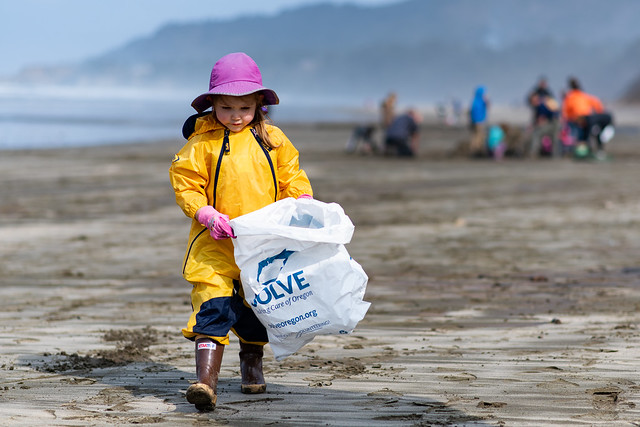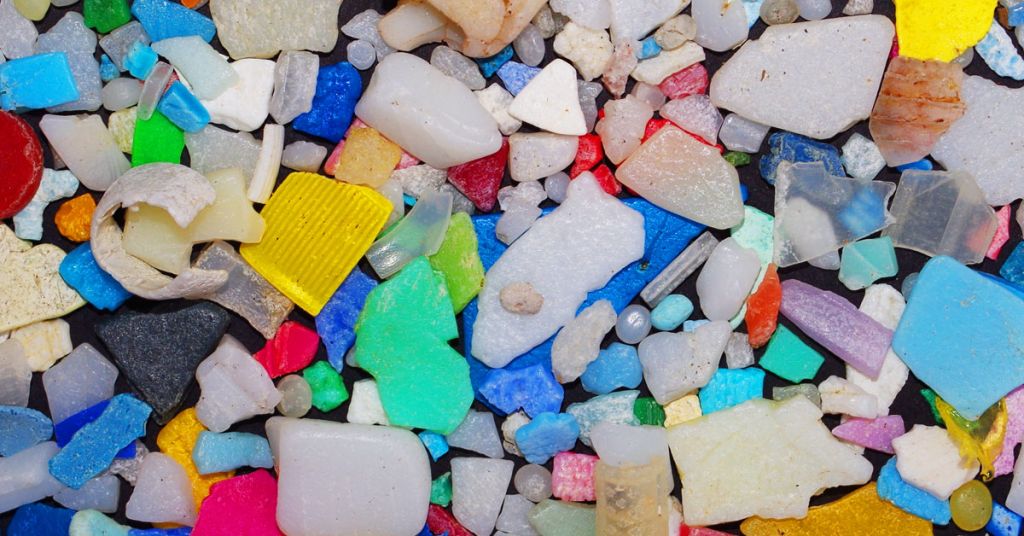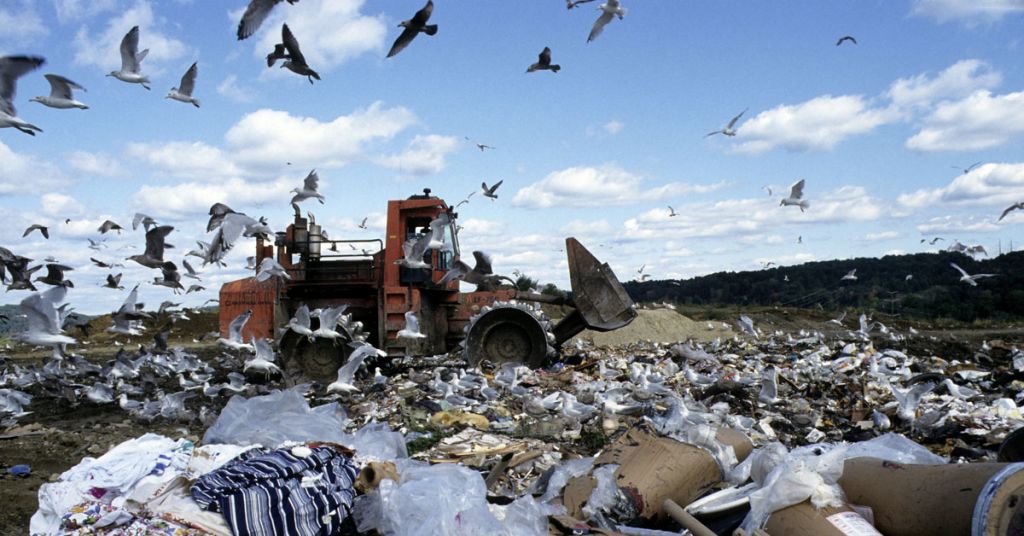
More microplastics are washing up on the Oregon coast every day, and this beach near Manzanita is no exception. Photo courtesy of the Ocean Blue Project
Emerging science shows microplastics have spread across the planet. We know they are in ocean waters in the Pacific Northwest, but most inland waters, including most of the Columbia River Basin, have simply not been surveyed. Do microplastics threaten ecosystem and human health? There’s plenty of reason for precaution.
By Valerie Brown. April 25, 2019. We’ve heard a lot about the planet’s overdose on plastics recently: sea turtles choking on plastic bags, a whale with kilograms of plastic in its stomach, vast gyres of multi-colored, multi-textured plastic slowly winding around the Pacific Ocean like Jupiter’s Great Red Spot. But this visible pollution represents only a fraction of all the plastic in the ocean. The majority is the size of sand grains or smaller — between approximately 10 nanometers and 5 millimeters — that were either reduced from bigger pieces by the elements or manufactured at that size originally. This is the scourge known as microplastics.
It would beggar belief to claim that microplastics pose no threat. Awareness of the problem is relatively high, but compared to the catastrophic effects of macroplastics, current knowledge of microplastics rests on incomplete science. However, the last 15 years have seen an “explosion” of research on plastics in the marine environment, writes Chelsea Rochman in the April issue of Science.
“Several hundred scientific publications now show that microplastics contaminate the world’s oceans, including marine species, at every level of the food chain. Yet scientists have only just begun to document and study microplastics in freshwater and terrestrial systems,” Rochman adds. And it seems that governments and activist groups in the Northwest are even farther behind.
A Global Perspective
Most microplastics in the ocean come from land, where they are washed down by rivers. A 2017 study showed that 67 percent of ocean plastics come from only 20 rivers, 15 of which are in Asia. China’s Yangtze and Pearl River deltas receive more than 20,000 metric tons per year, owing in large part to China’s position as the global leader in plastics manufacturing and its lack of waste capture and treatment infrastructure. Although the United States does have such infrastructure, we are second to China in generating plastic waste that is discarded rather than captured and/or recycled.

In Bulgaria, volunteers attempt to clean up a portion of Vacha Reservoir that is literally covered in plastic. Photo courtesy of Plastic Pollution Coalition
The supply of plastics is unlikely to taper off any time soon. Annual production of plastics in 2018 was about 550 million tons, up from 275 million tons in 2014. The World Economic Forum estimates that by 2050, marine plastics will equal the weight of all the fish in the oceans.
Not surprisingly given those production figures, plastic is found everywhere anyone looks: in the Arctic and Antarctic; in lakes and mountain streams, in sediments, in treated municipal wastewater, in glaciers. In bottled water. In sea salt. In deep ocean trenches. And inside most organisms, including humans. Microplastics are so ubiquitous now that they have been detected in our drinking water — even when it comes from relatively pristine sources — and our food, including fish, beer, sugar and honey.
Even in beautiful Columbia River Country?
The available scientific data about the Pacific Northwest suggests that the region is a minor player in microplastic marine pollution compared to the rest of the U.S. Along the entire west coast, no river dumps more than 200 tons of plastic waste a year into the ocean.
But that doesn’t mean we’re not part of the problem.
In 2017, a Spokane high school student found microplastics in two thirds of the river whitefish he sampled near the city’s wastewater treatment plant. Last October, Kirsten Kapp and Ellen Yeatman of Central Wyoming College and the University of Wyoming, respectively, published a survey of suspended and surface microplastics in grabbed and netted samples from 26 sites — from near the headwaters of the Snake River in Wyoming to the Snake’s confluence with the Columbia River, and from there to the mouth of the Columbia. They found microplastics in the vast majority of samples. The highest levels of microplastics were in areas of low population and high agricultural activity.

Microplastics are frequently consumed by fish living in rivers and, in the case of this rainbow runner, oceans like the North Pacific. Photo courtesy of 5 Gyres Institute
Risk vs. hazard
We know humans are not exempt from microplastic exposure. A Korean study of plastic content in sea salt estimated that adults may take in about 32,000 microplastic particles a year via inhalation and ingestion. But what’s the risk?
Some argue that microplastics must not be very harmful because some have been observed passing all the way through the human digestive tract. This might be true for single-exposure events. But chronic exposure to plastics can be hazardous. Bisphenol A is an endocrine disrupter, as are phthalates. Vinyl chloride and styrene, used as feedstock for plastics manufacture, are known carcinogens. Some plastics include lead and cadmium as colorants. Adding insult to injury, it’s likely that microplastics bioaccumulate so that, like mercury and PCBs, top predators end up with the highest exposures. And just to make things creepier, bacteria colonize the particles easily. A 2014 study of Chicago wastewater found pathogens common in human waste living on microplastics in the treated effluent.
Allen Burton, a University of Michigan aquatic toxicologist, does not believe that microplastics pose a threat…yet.
Burton, a panelist at a recent Water Research Foundation webcast, reminded participants that “the dose makes the poison,” and that marine and freshwater invertebrates are not exposed to the very high levels of microplastics used in laboratory studies that find harmful effects. In fact, Burton said, “Macro plastics are the source of the problem.” In addition, he said, most studies rely on visual identification of microplastics, which is notoriously difficult and probably inaccurate.

This tiny piece of plastic, found in Long Beach, Wash., may be more hazardous than the larger pieces of plastic you might notice elsewhere on the beach. Photo courtesy of Ocean Blue Project
However, we can’t assume that hazards of macro scale plastics predict those at micro scale. Size matters.
Microplastics may be more hazardous than larger pieces because the smaller a piece of matter is, the higher the ratio of its surface area to its mass. This means that a small object has more chances to react chemically with its environment than a large object made of the same material. Also, the more surface area, the more various other toxics in the environment stick to the particles. This property might be exploited for toxic cleanups, but it also means that an ingested plastic particle that may be toxic in itself can also lead to additional exposures to, say, PCB’s and organochlorine pesticides. Plus pathogens.
Fiber (in)security
The majority of plastic is manufactured for packaging, which the forces of nature reduce to tiny pellets, but it’s actually fibers that may pose the greatest risk. These include polyester, acrylic, nylon, and other oil-based materials. Economic forecasters predict synthetic fiber production will increase by 3.7 percent annually and will comprise 98 percent of total fiber production at least until 2025. In the Snake-Columbia sampling study, fibers comprised between 48 and 58 percent of the particles collected.
Most synthetic fiber pollution comes from clothing. A 2016 study found that a 13-pound load of laundry would shed more than 700,000 fibers. Polyester fleece, which has been “napped” to create its typical soft feel, sheds much more than basic knitted polyester fabric. Shedding is higher in a top-loading washer than a front-loading one, and filters in washing machines don’t capture the micro-scale fibers.
The extreme surface area of microfibers makes them much more likely to form twisted clumps and get stuck in an organism’s guts. Many invertebrates and small vertebrates starve as their innards fill up with these blobs, which prevent digestion of nutrients. Interestingly, while natural fibers are also found in the guts of various creatures, they are at much lower concentrations, and researchers suspect this is partly because they are both more digestible and more likely to break down harmlessly in the environment.
Municipal waste treatment captures most of America’s wash water, and panelists at the Water Research Foundation webcast noted that these systems in the U.S. are doing an excellent job of capturing 95 to 99 percent of synthetic fibers. But the remaining small percentage that isn’t captured is contaminating the global food web. Furthermore, while wastewater treatment does remove microplastics from water, it concentrates most of the them in biosolids and sludges, which are often spread on agricultural fields. This may not prevent microplastics’ eventual journey to the sea – not to mention the potential harm they can do to terrestrial ecosystems. Ironically, even some organic biosolids contain microplastics.
Wait…industry is ahead of the curve?
The plastics industry has begun to acknowledge its responsibility to manage plastics throughout their life cycle. The Coca-Cola company claims to be working towards a circular economy with its plastic bottles. Keith Christman, managing director of plastic markets for the American Chemistry Council (“Chemistry: The Science Behind Sustainability”) says the industry began to acknowledge that plastics pollution is unacceptable about a decade ago. Citing the recently-launched Alliance to End Plastic Waste, a $1.5 billion project sponsored by numerous companies all along the supply chain, Christman says the industry is now committed to stopping plastics from reaching the oceans. The Alliance aims to improve the sustainability of plastics manufacture and use at the primary sources by helping factories with wastewater treatment and capture of raw materials before they escape into waterways. The ACC itself wants its members to “reuse, recycle and recover all plastic packaging in the U.S. by 2040,” Christman said.

This mural, entitled “Choke-a-Cola”, calls attention to the suffocating effects that single-use plastic bottles have on marine life. Photo by Craig Sheppard
This worthy goal depends on buy-in from political stakeholders, including Asian nations. It may be possible, and according to the World Economic Forum, China is the most progressive country in terms of reducing plastics pollution.
This is one environmental issue where industry appears to be ahead of government. In Oregon, the Department of Environmental Quality is aware of the microplastics issue, including in treated wastewater biosolids. And according to DEQ public affairs spokesperson Susan Mills, Oregon will likely not move to regulate microplastics until or unless the U.S. Environmental Protection Agency decides how serious the threat is. At this point, the EPA views microplastics as “an emerging contaminant of concern,” Mills says, and she knows of no EPA timetable for that decision.
Overall, the U.S. government is not supporting much research on either the problem or potential solutions, according to Burton. Fortunately, he says, the European Union is spending “a crazy amount of money” on microplastics research — and actually regulating plastic waste. Last October the EU banned single-use plastics like bags, straws and cutlery altogether. The U.S. Congress banned microbeads (only from “rinse-off cosmetics”) in 2015, but no further federal action has been taken. Six U.S. cities, six counties and seven states have banned or restricted plastic bags. In an act of especially unhelpful legislation, Arizona now “prevents a city, town or county from regulating the sale, use or disposition of plastic bags.” Similar restrictions have passed in Idaho, Missouri, and North Carolina.
The greatest tragedy is that once plastic is ground down to micro-scale and gets into the ocean, there is no getting it out. Only the lightest forms remain at the surface, and more dense particles fall to the ocean floor, where they remain in the sediment for the foreseeable future unless they are taken up the food chain and bioaccumulate in organisms. The same is likely true of freshwater environments like stillwater behind dams. While there is evidence that one type of bacteria can digest single-use bottles, we are nowhere near being able to exploit them. Ultimately, only complete life cycle management of plastics will enable us to keep using them at all. But some improvement is better than none, and by acknowledging the problem we are one step closer to finding a solution.
What you can do right now to minimize the microplastic problem:

Part of the solution, a young girl hunts for plastic treasure on the Oregon Coast. Photo by Charles Mitchell, courtesy of Surfrider Foundation Oregon
1. Capture fibers in your washing machine with a Guppyfriend or a Cora ball.
2. Buy natural fibers, if you can afford it, or at least natural/synthetic blends. (Synthetic fibers such as polyester and acrylic are always less expensive, placing an economic disincentive on doing the right thing.)
3. Even if they are still legal in your area, stop using plastic bags. Eliminate plastic cutlery, straws and stir-sticks from your life. Say no to plastic utensils and cups. And if you are flushing Q-Tips and contact lenses down the toilet, stop it!
4. Apply pressure on your elected representatives to implement meaningful policies and regulations regarding both packaging and fibers.
5. Participate in beach, lake and river cleanups.










A highly informative article and gives options to help us change our habits. the photo of the fish and its guts, shows it all. Put that on a billboard!
jmk
Valerie, excellent article. I learned a lot. Like fleece clothes sheds plastic as it’s washed. Great on what we can all do.,Jurgen Hess
Thanks for this great piece, VJB! (It’s right up one of my alleys.)
Our MA town recently voted to ban single-use plastic checkout bags, becoming the 96th MA municipality to do so. There are a couple of bills in the state legislature that would ban plastic bags, and we’re very hopeful it will pass in this session. The local efforts have created significant momentum and may help push this across the line. As is the case in this political moment, most of the movement on enviro stuff is happening at the state and local levels.
I’d love more coverage (not demanding this of you!) of the need to reduce, urgently and dramatically, our demand for plastics, as well as the (relative) dead end that recycling, with minor exceptions, really is.
What I have the worst time with is plastic bags for produce. I don’t like to just carry lettuce and celery and mushrooms around without protection, and I have not found an acceptable green substitute to the bags the grocery store tells me the state requires to be made available for hygienic reasons. I was thinking grocery store/farmers’ markets etc. should just charge by the pound, so the shopper could bring one big bag and reuse it and re-distribute the produce in the home where other options could be available. Deb, do you know if that’s ever been considered by, say, the Acton-Boxborough market? I wonder if the cost per veg/fruit would even out. You could get a lot more leafy greens and mushrooms in a pound than a couple of potatoes, and that would encourage us all to eat more leafy greens!
And of course we should stop producing and using plastics. I can’t see that ever happening. We need those microbes to get up to speed…